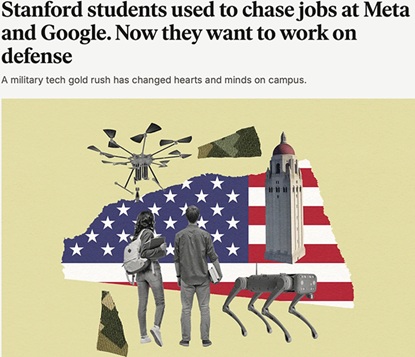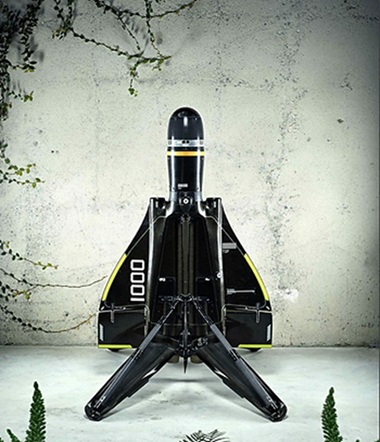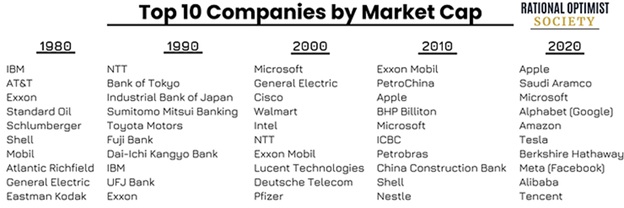In 2018, thousands of Google (GOOG) employees signed a petition demanding Google sever ties with the Pentagon’s artificial intelligence (AI) initiatives.
“We believe that Google should not be in the business of war,” the petition read.
Google complied.
The rest of the tech world mostly agreed: We want nothing to do with the US military.
Oh man, what a difference a few years makes. Stanford’s brightest kids are now dropping out to launch defense tech startups:

Source: The San Francisco Standard
A critical mass of these impressive young founders is now clustered in a gritty refinery town outside LA.
Unlike their predecessors, they’re not working on social media apps. They’re working on new physical technologies, mostly for the defense industry.
So, what happened?
You probably know the name Palmer Luckey…
At 19 years old, Luckey created the Oculus Rift while living in a camper van parked in his parent’s driveway.
It was the first VR headset good enough to go mainstream. Meta Platforms (META) acquired his company for $2 billion.
These days, Palmer Luckey is building more important stuff: self-flying drones and fighter jets that will revolutionize the battlefield.
His company Anduril, while still private, is already one of America's 10 most important companies. Its innovations include:
Roadrunner. A drone that takes off like a helicopter but flies like a jet. It waits quietly until enemy drones appear, then screams toward them at jet speed, knocking them out of the sky.

Source: Anduril
Fury. A fully autonomous drone that attacks in swarms traveling at 700 mph.
Ghost. The invisible guardian that hovers over battlefields and can spot a person climbing a fence three miles away, day or night.
Anduril just landed its biggest win ever: a $22 billion contract with the US Army to build augmented reality helmets, complete with thermal vision that allows soldiers to detect threats through walls.
We owe Anduril gratitude.
Until recently, military tech startups were considered “uninvestable.”
Anduril has made defense tech exciting. It blazed a trail once considered impenetrable for startups. Now, a flood of entrepreneurs is following in its footsteps.
Here are six revolutionary small companies to watch:
- Castelion—founded by former SpaceX engineers—is building hypersonic missiles that can cross the Atlantic in under 30 minutes and outmaneuver any defense system.
- Shield AI makes autonomous drones that fly in “wolf packs” without GPS or human pilots, making them immune to enemy radar.
- Epirus builds microwave weapons that fry enemy drones in mid-air. It can knock swarms of 100+ drones out of the sky.
- Saronic is building unmanned naval ships that patrol oceans for weeks without a crew. Hello, robo-Navy.
- Antares is developing portable nuclear reactors that can power remote military bases and even ships, eliminating the need for fuel supply convoys.
- All these revolutionary systems need someone to build them. Hadrian is using AI-powered robotics to make defense components 10X faster at half the cost of traditional methods.
How can you not be excited about what these companies are building?
It just goes to show how military tech is transforming from an inefficient, flexible industry to a source of innovation shaping our world.
In fact, this industry towers over all others when it comes to raw, physical, cutting-edge innovation.
And this military innovation was desperately needed…
Today, just five companies capture over 80% of defense dollars: Lockheed Martin (LMT), Boeing (BA), General Dynamics (GD), Raytheon (RTX), and Northrop Grumman (NOC).
Half of all defense contracts face zero competition. Zero competition means zero innovation.
The Big 5 defense contractors aren’t just dinosaurs. They’re vampires, sucking dollars from taxpayers through cost-plus contracts.
Defense contractors are guaranteed their costs, plus a fixed percentage fee on top. The more a project costs and the longer it takes, the more money it makes.
One of my contacts at Palantir Technologies (PLTR) told me the real mess is on the buyer’s side. The Army, Navy, and Air Force used to compete fiercely, each building their own planes and systems, racing to outdo each other. That rivalry sparked rapid innovation.
Then the Pentagon consolidated into one giant buyer, becoming a monopsony. Stagnation followed.
Meanwhile, Anduril builds weapons like a tech company builds apps.
It knows small, unmanned, affordable swarms beat big, manned, overpriced relics.
It developed Roadrunner in two years for less than $250 million. Lockheed's equivalent took 14 years and $70 billion. Choose your fighter.
This is creative destruction at its finest. The Big 5 must die so the arsenal of innovation can be born again.
Many of these founders only graduated high school, proving once again you don’t need a prestigious degree to build real things that matter.
This is the rebirth of American innovation in its most authentic form. Nonconforming, ambitious people made this country a technological superpower in the first place.
Can you name the world’s most valuable private company?
It’s SpaceX, valued at $350 billion. Elon Musk started SpaceX in a warehouse in El Segundo. It’s now worth more than Bank of America (BAC) or Coca-Cola (KO).
I think defense tech is the next market "zeitgeist"—the next major investment theme that will capture imaginations and mint fortunes.
My friend Louis Gave of Gavekal first showed me this table in 2017. I’ve been obsessed with it ever since. It shows the 10 most valuable companies by decade.
Each decade has a dominant theme. The ’80s were all about oil companies. Japan dominated the ’90s. Tech rose in the 2000s. Oil companies made a comeback in the 2010s... then, a new breed of tech stocks dominated by 2020.

By 2030, I think aerospace and defense tech businesses will appear on this list. SpaceX and Palantir are just the vanguard. Anduril, still private, will hit a $100+ billion valuation.
Tomorrow's defense tech giants will go "back to the future," returning to an era when America's industrial might served both military and civilian needs.
During WWII, Ford (F) wasn’t just churning out Model Ts. It pumped out a B-24 Liberator bomber every hour. General Mills (GIS) made Cheerios for breakfast and precision bombsights for soldiers.
SpaceX’s Starlink satellites deliver high-speed internet to millions of people around the world. SpaceX also launches classified spy satellites for the US military.
Palantir software helped Wendy’s optimize its supply chain. Its software also reportedly helped catch Osama Bin Laden. See where this is going?
Pay attention to these companies because they'll become the most valuable businesses on Earth in the coming years.
Related: The Big Financial Shift No One’s Paying Attention To
PS: Every week, I publish insights on where I see the world—and the markets—heading. Subscribe to my free investing letter, The Jolt, and never miss a beat.

